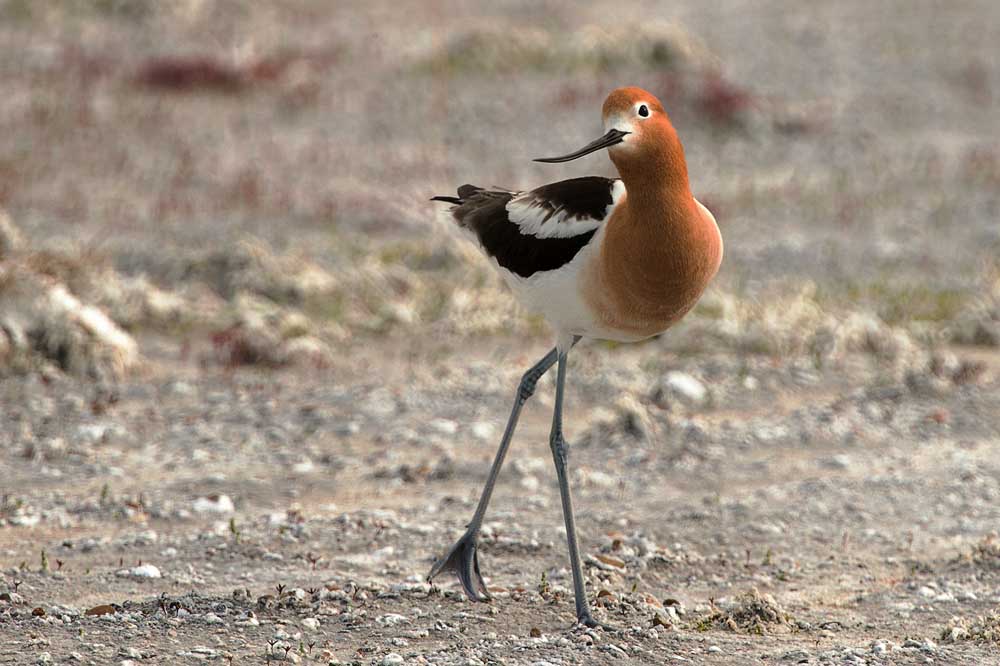Montana refuge a haven for migratory and grassland birds
Published 12:00 am Wednesday, September 9, 2015

- Ben Pierce / The Bozeman (Mont.) Daily ChronicleAn American avocet walks through an alkali flat on the Bowdoin National Wildlife Refuge, east of Malta, Montana. More than 260 birds frequent the refuge.
MALTA, Mont. — The Sprague’s pipit is a tiny grassland bird very similar in appearance to the Horned Lark. Its pale face and streaked breast allow the Sprague’s pipit to conceal itself in shortgrass prairie. The bird flies steeply when flushed before tucking its wings and plummeting distinctly back to the earth.
Sprague’s pipits nest and winter in the prairie habitat of the Bowdoin National Wildlife Refuge just east of Malta along Montana’s Hi-Line. They are one of more than 260 birds that frequent the refuge.
“We have grassland songbirds including the Sprague’s pipit, Baird’s sparrow and chestnut-collared longspur,” said Jessica Larson, BNWR wildlife biologist. “Birders typically come for the upland birds and some come to see the waterfowl, but we will get people coming through just to see those three grassland songbirds.”
The BNWR sits on an ancient oxbow of the Missouri River that cut through the area thousands of years ago. During early land surveys of Montana conducted in the late 1800s, Bowdoin Lake was known as Alkali Lake.
During the early 1900s, the Montana Hi-Line became an important agricultural region. The Bureau of Reclamation began using Bowdoin Lake and the area of the future refuge as a reservoir for used irrigation water. The resulting wetland habitat attracted ducks, geese, swans and numerous other bird species. In 1936, the BNWR was formed to protect the wetlands and wildlife as a migratory bird refuge.
Today, a 15-mile auto tour ushers visitors around Bowdoin Lake. The route passes through grasslands and along the lake shore offering numerous vantage points from which to observe birdlife and take in the views. The Display Pond near the refuge headquarters has a paved path and bird blind for those interested in a shorter outing.
In addition to Lake Bowdoin, the 15,551-acre refuge includes several other smaller lakes and ponds. The auto tour leads through the marshlands of the Lakeside Unit and Dry Lake Unit where visitors get an intimate view of thriving wetland habitat.
In the spring and summer large flocks of American avocet and black-necked stilts can be observed wading in the alkali flats along the shoreline. These shorebirds look a bit out of place, but they’re not.
“With their color, long legs and elegant bodies, you don’t expect to see them on the prairie, but they are very much prairie birds,” Larson said. “Avocets are the jewels of the wetland, but they lose their rusty color through the summer. By the time they leave they are primarily white and black.”
The BNWF exists as part of the larger Bowdoin National Wildlife Refuge Complex, a vast 84,724-acre swath of water and land in Blaine, Hill, Phillips and Valley counties. The complex includes BNWR, Black Coulee, Creedman Coulee, Hewitt Lake and Lake Thibadeau National Wildlife Refuges, and nine waterfowl production areas.
The complex is part of the Prairie Pothole Region, which stretches from the Rocky Mountain Front east to Minnesota. The region is known as the nation’s “duck factory” and provides critical habitat for migratory waterfowl.
Ducks of all types visit the BNWF, many nesting and raising their young in the tall grasses and wetlands. Hunters flock to Bowdoin Lake in the fall when the refuge sees a notable influx of waterfowl and upland game bird hunters.
“The Prairie Pothole Region is the perfect habitat for ducks to come, lay their eggs and nest,” Larson said. “They key in on the grasses and wetlands. Without the Prairie Potholes, we wouldn’t have the ducks that we have.”
A hot-button issue for hunters on the Bowdoin is the removal by the refuge of invasive Russian olive trees. Endemic to Europe and western Asia, the trees create good cover for upland game birds, but they also crowd out native species and spread quickly.
“We have to manage for all the birds and wildlife, not just pheasant,” Larson said.
Prime time to visit BNWR is in the spring and fall. From mid-May to mid-June, numerous species of songbirds move into the area.
The summer sees colonial nesting birds such as great blue heron, double-crested cormorant and American white pelican.
“In the cattail and bulrush areas of refuge wetlands, there are colonies of over water nesters such as white-faced ibis and Franklin’s gulls,” the refuge website says. “Eared grebes build a floating nest of aquatic vegetation on which to lay their eggs. Like other grebes, the young can be seen ‘hitching’ a ride on the back of one of their parents.”
In the fall, waterfowl and tundra swans cover the lake. The tundra swans show up in mid-October and stick around until Bowdoin Lake freezes over before flying south for the winter.
“You can come up any time, there is always something to see,” Larson said. “But spring and fall is when you get the wow factor.”






